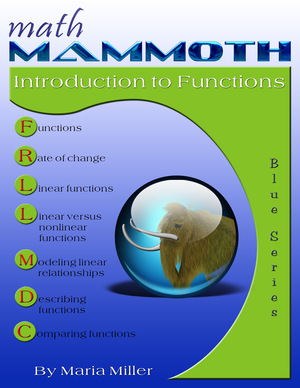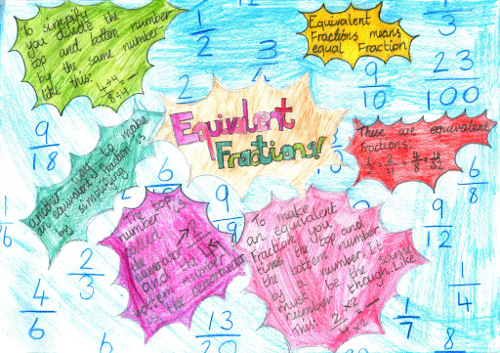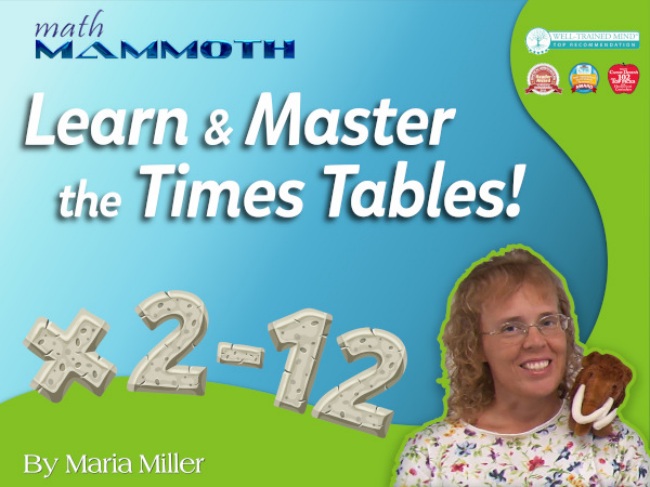 Hello and happy new year 2023! 😀 I hope it will be prosperous, and a good year, in spite of some of the ways the world is going.
Hello and happy new year 2023! 😀 I hope it will be prosperous, and a good year, in spite of some of the ways the world is going.
|
1. Math Mammoth newsSome of you like to plan ahead... there will be a new edition for grade 5 sometime in 2023. Probably in the late spring.A new book in the Blue series, for grade 8: Introduction to Functions.  This book covers various introductory topics from the theory of functions, following the
CCS for 8th grade.
This book covers various introductory topics from the theory of functions, following the
CCS for 8th grade.
The topics covered include: concept of a function, rate of change, linear and nonlinear functions, modeling with linear functions, describing functions, and comparing functions. These topics prepare students for studying functions in great detail in high school math. Sample pages (PDF) Contents Rate of Change Linear vs. Nonlinear Functions Describing Functions 2 My traditional January sale is just around the corner — starting in January 15, you can get all downloads and CDs for 25% off! |
2. PEMDASI don't feel there's anything wrong with PEMDAS as such (to teach the order of operations), but this post points out a difficulty many students have: it's kind of hard for them to remember/understand the in "PEMDAS", multiplications and divisions are "on the same level" — multiplications are NOT to be done before all divisions, but from left to right.For example, in 24 / 4 × 2, we do 24/4 first, not 4 × 2. And it works similarly with addition and subtraction (the "AS" part of PEMDAS): In 24 − 4 + 5, we do the subtraction first.  This blogger suggests an alternative mnemonic - GEMA, which stands for:
This blogger suggests an alternative mnemonic - GEMA, which stands for:
Grouping symbols Exponential operations (this includes roots) Multiplicative operations Additive operations Interesting! |
3. Why are fractions so difficult?I have updated my article on the topic of Why are fractions so difficult? 😀What makes it difficult is that there are MANY "operations" (ways to manipulate fractions), and the rules for these use the common operations with whole numbers in a myriad of different ways. If students don't understand where these rules come from, they can seem like a meaningless jungle, like "magic", where you do various random things with the numerators and denominators to come up with the answer. To help children master fractions, I like to use visual models or manipulatives in a more extensive manner than most curricula do. In Math Mammoth materials, students solve lots of problems with visual models or fraction manipulatives. See examples: Why are fractions so difficult? |
4. The interactive multiplication courseMy interactive multiplication course at TinyTap is now COMPLETE with all tables, up to the 12 times table!You will get access to 20 interactive lessons that contain videos and interactive exercises. Some lessons focus on a particular multiplication table, while others are for reinforcing earlier concepts and skills. The lessons contain not only simple practice, but also word problems, puzzles, and other types of multiplication exercises. The price for this NEW YEAR is $11.99 (expected to go up so act now!). See an example lesson: The Multiplication Table of 5 |
5. 2023 Year Game!It's time for the 2023 year game! Happy new year, everyone!If you've never played this game, it's very simple and accessible to children from about 3rd grade onward. Simply use the digits 2, 0, 2, and 3 and common math operations to make the counting numbers from 1 to 100. For younger students, you could limit this, say, to the first 10 or 20 counting numbers. Here's one example: 2 ÷ 2 + 3 + 0 = 4 Official rules for the 2023 Year Game |
6. Just for fun!
Thanks for reading! 🙂 Feel free to forward this issue to a friend/colleague! Subscribe here. Till next time, Maria Miller |
| Complete curriculum | Math games and interactive practice | Math Mammoth freebies | New to MM? Start here |
| Privacy & your personal data | Consider the Elephant | Blue Series: For filling in gaps |


